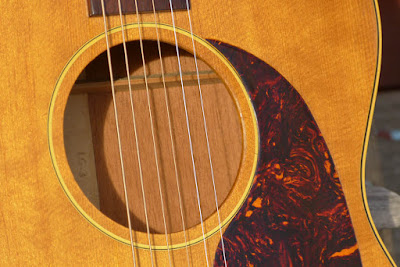1954 Gibson LG-3 Flattop Guitar
This is a painfully-pretty example of a mid-50s LG-3. This body shape and size has long been my favorite of Gibson's flattops as they're big enough to sound gutsy and proud while small enough to be comfortable for long sessions and easy to haul around. The 50s models definitely have that dry, rootsy, defined sound that adores both full-on flatpicking and strumming and fingerpicking, both. This makes them ideal for old-time backup and country-blues styles as well as singer-songwriter thumping. The sound of this particular guitar its up-front and big and it's a joy to play.
It's also very, very clean for its age and aside from my new bone saddle and new tuner buttons, is entirely original. There's weather-check to the finish all over but only one (1/4" and repaired) hairline crack at the soundhole edge. The finish has also aged to that beautiful buttery-yellow color and, as you can see in the pics, the sunlight really picks out some pretty curly-looking figure in the grain of the top.
It's also very, very clean for its age and aside from my new bone saddle and new tuner buttons, is entirely original. There's weather-check to the finish all over but only one (1/4" and repaired) hairline crack at the soundhole edge. The finish has also aged to that beautiful buttery-yellow color and, as you can see in the pics, the sunlight really picks out some pretty curly-looking figure in the grain of the top.
LG-3s are essentially LG-2s with a natural finish. They're 00-size guitars in a vaguely classical-guitar shape and have an x-braced spruced top and solid mahogany back, sides, and neck. The bridge and board on this are both Brazilian rosewood.
My only work included making a new bone (compensated) saddle to replace a cheesy plastic one, addition of new tuner buttons (the originals were crumbled-off), a fret level/dress, and light cleaning and setup. It plays spot-on at 3/32" EA and 1/16" DGB&E at the 12th fret and has a good, straight neck with functioning truss rod. It's good to go.
There's the above-mentioned tiny 1/4" hairline crack at the soundhole edge that was cleated in the past and the center-seam looks like it had the tiniest-ever fill/seal job at some point, too.
The plastic nut, when compared to other '54 LG-3s and LG-2s, looks original to me. It's 1 11/16" in width and the neck profile is a nice medium-sized Gibson C profile in depth.
Nice board, huh? It has the original, smaller, Gibson frets, pearl dot inlay, and a 14" radius. The feel is definitely in "grown man's guitar" territory, as most 50s Gibs are.
It's hard to beat the look of the understated Gibson rosette with a teardrop pickguard.
During setup I cleaned-up the saddle slot, added light string-ramping to improve back-angle on the strings, and made a new bone saddle with proper compensation.
The strings are a custom balanced-tension set at 54w, 40w, 30w, 22w, 17, 13. This has slightly less tension than a standard 54w-12 "light" set but has a more even response and feel and the treble has the punch it deserves. You can hear this in the soundclip -- it really suits the shorter 24 3/4" scale this guitar has, too.
Nice tuners, right? I re-button with black buttons because there isn't a proper modern "cream" colored button to retrofit that matches originals. Black, at least, looks like it could be period.
The neck set and angle are good to go.
The only really obvious "bump" is this curious mark on the treble side (upper bout). It looks like something hot or sticky interfered with the finish but doesn't hurt the guitar at all.
The original chip case is included but has one hinge damaged. It's good for the history and storage, however.























Comments